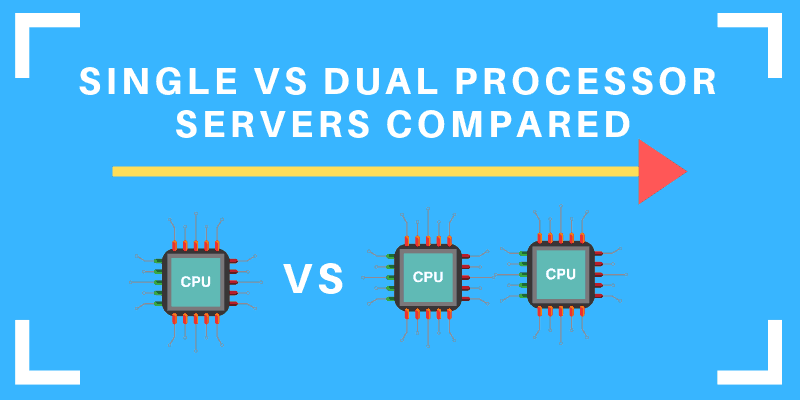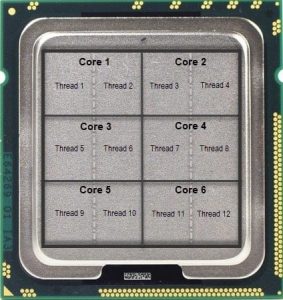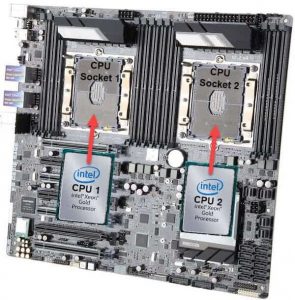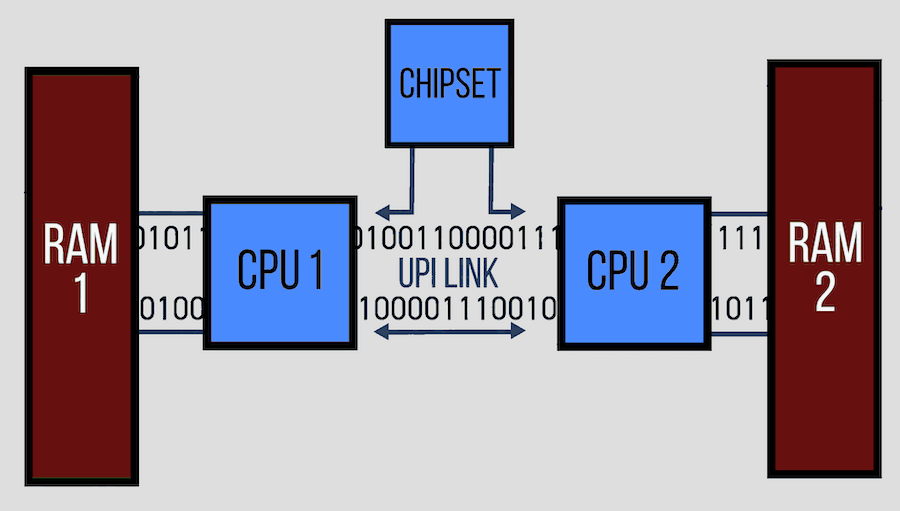In the market for a dedicated or bare metal server? There is an abundance of configurations to choose from.
It is critical to determine a server configuration that meets your demands.
The backbone of any server is the number of CPUs that will power it, as well as the actual model and the type of the CPU. From that point, you add the needed amount of RAM, storage and other options that your use case requires.
After reading this article, you should be able to understand the differences between a single processor and a dual processor server. If you are planning to build a bare metal environment for your workload, one of the questions is whether to go for a single or dual processor setup.
This article should steer you towards making a proper decision for your future infrastructure needs.
Differences Between a CPU, Core, and Threads
Back in the day when computers started entering every aspect of our lives, we could not even imagine a multi-core CPU. It was a battle of high CPU core clock speeds. The higher the clock speed, the faster a CPU could process information.
When single-core CPUs were no longer sufficient, manufacturers started developing chips with multiple cores and threads. Soon enough, we started seeing servers with multiple CPUs on one motherboard. But what is the difference between a CPU, a core, and a thread? Read along for a brief overview.
What is a CPU?
A CPU (Central Processing Unit) is a piece of hardware responsible for executing tasks from other parts of a computer.
Single core CPUs were able to handle only one set of instructions at a time. Virtually all modern CPUs contain multiple cores now. This enables the execution of multiple tasks at the same time.
What is a CPU Core?
A Core is a physical part of a CPU. Cores act like processors within a single CPU chip. The more cores a CPU has, the more tasks it can perform simultaneously.
One core can perform one task at a time while other cores handle other tasks the system assigns. This way, the overall performance is substantially improved when compared to old single-core CPUs. There are also logical cores that function as separate threads within a core. While they boost performance, logical cores are not a match for physical cores.
What are CPU Threads?
Threads are like paths your computer can take to process information.
If a CPU has six cores with two threads per core, that means there are twelve paths for information to be processed.
The main difference between threads and physical cores is that two threads cannot operate in parallel. While two physical cores can simultaneously perform two tasks, one core alternates between the threads. This happens fast so that it appears that true multitasking takes place.
Single Processor Servers – Benefits & Facts
Single processor servers run on a motherboard with one socket for a CPU. This means that the highest core-count CPU available on the market determines the maximum core-count per server. On the bright side, today’s CPU market offers many high-performance units that can handle intensive workloads.
The most powerful chips belong to the Intel® Xeon® Scalable Processor Family with a maximum of 28 cores and 56 threads. However, Intel® Xeon® Scalable Processors are almost exclusively a part of multiprocessor setups.
The majority of recent single processor servers utilize CPUs that belong to Intel® Xeon® E family, the successor to the Xeon E3 family. The most cost-effective choice is the Intel® Xeon® E-2186G CPU from the latest Coffee Lake product line. With 6 cores clocked at 3.8 GHz (4.7 GHz Turbo Boost), 12 threads and 128GB ECC RAM support (after a bios update, coming in the first quarter) you can run multiple different services 24/7 without any issues.
The Intel® Xeon® E-2100 processors brought numerous improvements in performance, security, and reliability to single processor server setups. Nonetheless, RAM capacity constraints with single CPU configurations remain one of their biggest drawbacks.
Use Cases for Single Processor Servers
The advance of CPU technology allowed single processor servers to handle intensive workloads. This strictly depends on the model of the CPU that powers the servers as well as other components, such as the amount of RAM.
Since the discrepancy between the single processor server configurations can be significant, it is useful to divide them into a few categories. This is by no means an official categorization of servers. It is simply a high-level classification so you can get a general idea of how we can use single processor servers.
Low Segment
With low-end entry-level single processor servers, you can expect to build a general application server for a smaller organization. This includes a mail server for a dozen, or so, active employees. Learn more about application servers by referring to our article Web Servers vs Applications Servers.
Cost-effective single processor servers can provide machines powerful enough for a development and test environment for your team of programmers. In this segment, you can also expect to set up your own DNS server.
Most modern entry-level servers support error-correcting code (ECC) memory. It corrects emerging data corruption, prevents potential system crashes and helps to keep the system running around the clock.
Middle Segment
The single processor server lineup in the middle segment is also diverse. A server like this still won’t break your bank but will manage to run all services mentioned above, but for a larger organization. Additionally, mid-range machines are a good fit for a moderate volume webshop or smaller online games server.
Organizations can also deploy these machines as collaboration servers for fluent data exchange between different sectors. Since data may change at the same time in different locations, collaboration servers keep track of the changes and deal with proper synchronization.
There are many different applications for collaborative servers ranging from interactive 3D experiences to project management tools.
High Segment
If the budget allows for a top-spec single processor server, you can create a high core-count machine for more intensive workloads. Some of those applications include certain scientific simulations and statistical computations.
Other than that, large volume websites and online stores can effectively run on these robust servers. You can also create a smaller virtual environment and make a multi-purpose server using one unit.
For the crème de la crème single processor servers, we left media processing and streaming. Those beasts with 20+ cores can easily handle video processing for average online media consumption. High-end servers are also suitable for potential scaling and high-speed server clusters for intensive workloads.
Dual Processor Servers – Benefits and Facts
The most apparent distinction between single and dual processor servers is that the motherboard has two CPU sockets instead of one.
This is followed by additional benefits such as the massive amount of PCI lanes, two separate sets of cache memory and two sets of RAM slots. If the specific motherboard has 24 memory slots, 12 slots belong to the first CPU and the other 12 to the other CPU. In cases where only one CPU slot is occupied, the CPU cannot use the other set of RAM sticks. This rarely happens since dual processor servers always have both slots occupied. The Intel® Xeon® Gold Processor lineup is the most cost-effective option for dual processor setups. These include Intel® Xeon® Gold 5118 or Intel® Xeon® Gold 6130 if you need more cache and higher clock speeds.
One thing to bear in mind about dual processor servers is the presence of a necessary latency in such systems. This refers to the compute tasks that require the same data sets. To efficiently share the available resources and avoid interrupting each other, there is a need for NUMA (non-uniform memory access). This helps with assigning available memory and devices to each CPU making the latency times as low as possible. But, in the workloads intended for these servers, this is not an issue.
Dual processor servers and multiprocessor systems, in general, are the best options for space-restricted environments. When a business requires as much compute power as possible in a single unit, they need to use multi-socket setups to fit a large number of servers in a constricted space.
Use Cases – Dual Processor Servers
Quite often dual processor servers contain those top of the line processor chips. This makes them suitable for virtually every market segment and business use case. Note that typical small business applications will not benefit from the high core-count.
Where these servers really shine is in multi-threaded CPU intensive applications such as scientific high precision computations and simulations. The same goes for machine and deep learning, render farms and similar HPC deployments where an extreme amount of CPU calculation takes place.
Environments using a large database tasked with numerous simultaneous queries take advantage of servers powered by two CPUs and as many cores as possible. The more cores are available, the more database tasks a system can handle. Dual processor servers can even handle multiple databases on a single machine due to the sheer number of processing power.
These servers shine when they serve as the basis for a virtual environment or the backbone of a server cluster. With up to 56 cores and double the threads, you can even assign physical cores to your virtual machines for better performance and stability.
You may have noticed that we did not create a classification of dual CPU servers in different segments. The main reason is if you are in the market for a dual CPU server, you are already deep in the high segment of the computing world. Still, providers have outlet offers for dual CPU machines where you can lease a bare metal server without breaking the bank.
Performance Comparison: Single vs. Dual Processor Servers
As it is usually the case, the more, the better. Higher core-count machines certainly outperform those servers with six or eight cores and a single CPU chip. However, not everything is so simple.
While dual CPU setups pack enormous core counts and outshine single processor servers by a large margin, some tests have shown only a marginal performance increase over single CPU configurations with similar core-count and clock speeds per chip. This refers to the circumstances where two CPUs worked on the same data at the same time.
On the other hand, we see immense performance boosts in dual processor servers when the workload is optimized for setups like these. This is especially true when CPUs carry out intensive multi-threaded tasks. One of them is abstracting the resources into virtual machines that work on separate things at the same time.
The sheer processor speed and core-count is not always detrimental. Dual processor servers support much more RAM than it is the case with single processor servers. For example, Intel® Xeon® Gold 5118 Scalable Processors has a maximum declared memory size of 768GB. On the other hand, the Xeon E-2100 processor line supports up to 128GB of RAM after BIOS update.
To affirm the multiprocessor server performance precedence over single processor setups, the first half of 2019 will bring Intel® Optane
Choosing the Right Server Setup
There is no magic formula on how to determine if you need a low-end single processor server or a dual processor monster. There are multiple factors that play a major role in this decision. This also depends on whether you want to lease a server or buy one. In today’s market, it is usually more cost-effective to lease a server than build an in-house data-center. The reason is the amount of work involved in setting up the proper air conditioning, power, cabling and everything else you need to run a stable data center.
Here are some of the guidelines for determining the right bare metal server for your business:
- Make a list of what for you intend to use the server. Note the requirements of the software you plan to run.
- Try to anticipate possible workloads. You want to have sufficient resources during peak times, but not too much hardware sitting idle during average and low consumption.
- Make sure the costs of running your IT environment does not exceed the benefits it brings.
- If you plan to provide some sort of online service to your clients, make sure to meet their expectations. Especially if you have an SLA to follow.
Conclusion
Single processor servers hold a large portion of today’s market. With massive core-count CPU chips, it may seem that dual processor servers are best suited for enterprise environments and data centers. Those buildings need to house as many cores per unit as possible to save space.
High-performance servers underpin successful business operations and drive forward the scientific research and development. That is why it is essential to choose the proper server for your IT infrastructure. If you need any help in making this decision, you may want to turn to professionals. You can also contact phoenixNAP experts directly for assistance in choosing the right server for your workload.



